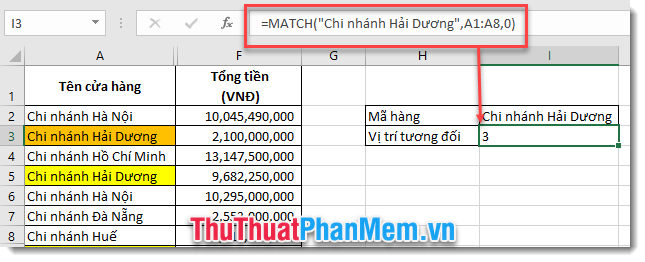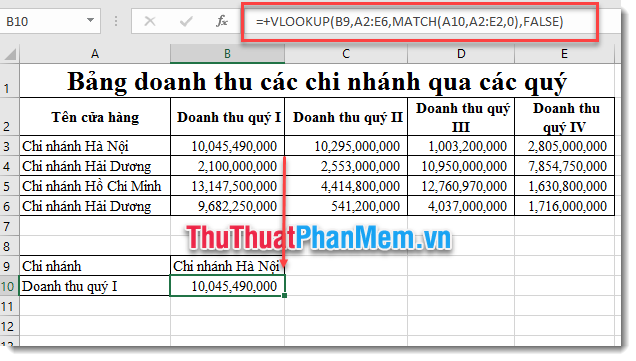Match function in Excel - Usage and illustrative examples
The Match function in Excel finds a specified item in a specified range and, returns the relative position of that value in this range.

Function syntax and usage
Syntax: = MATCH (lookup_value, lookup_array, [match_type]).
Inside:
- MATCH : is the function name.
- lookup_value: is the value to search, be it text or numeric.
- lookup_array: is the search array.
- [match_type]: is a match type. Optional parameter. If you do not enter a value, Excel will default to the match type = l.
+ If you type match = 1: is to find the largest value in values that is less than or equal to the value you are looking for that you specified above.
+ If you type match = 0: is to find the correct value equal to the value to search.
+ If you type match = - 1: is to find the smallest value in the values greater than or equal to the value you are looking for that you specified above.
Note:
- If you use match_type = 1, the search array must be sorted in ascending order, for example: a, b, c, etc; -2,0,3,4, etc.
- If you use match_type = -1, the search array must be sorted in descending order.
- If lookup_value is case sensitive, double quotes must be entered.
- The Match function is not case sensitive.
- If the Match function is not found, the result will return the # N / A error value .
- If match_type = 0 and lookup_value are text strings, you can use the question mark character (?) To represent any single character and the asterisk (*) that matches any string. If you want to find a real question mark or asterisk, type a tilde (~) before the character.
- If the lookup_array search array has more than one value of lookup_value, the result will return the smallest result.
For example

In the above example, lookup_value is in text form, so you must enclose the quotation marks "". Otherwise the return value will be #NAME?
The lookup_array search array has the same value as lookup_value (Hai Duong branch), the function will return the first value it meets.
Use the Match function, which is case sensitive
The formula: = MATCH (TRUE, EXACT (lookup_array, lookup_value, [match_type]) and then press Shift + Ctrl + Enter instead of just Enter as usual.
The Exact function will help us compare the lookup value ( lookup_value) with each value in the search area ( lookup_array ). If the compared cell does not match 100% of the value to be searched, the function will return False until the return value is True (the cell that matches 100% matches the value to be searched). And then the Match function will check the position of the True value in the search area ( lookup_array ).
You can refer to the following example to see the difference between using the Match function (1) and using the Match function in combination with Exact (2).

Combine MATCH with the Lookup search function
You can use the Match function to get the relative position of the column / row you need to return, and provide the column / row number for the Row_index_number parameter for the Hlookup function / the Col_index_number parameter for the Vlookup function.
You have the following example is a combination of Vlookup and Match rows

In particular, the Match function finds the position of "First Quarter Revenue" in the array A2 through E2, and returns the value 2 for the Col_index_number parameter for the Vlookup function.
And another example for a combination of Hlookup and Match rows

In particular, the Match function finds the position of "Hanoi Branch" in the array A2 through A6, and returns the row value 2 for the Row_index_number parameter for the Hlookup function.
Above software tips have shown you how to use the MATCH function and some of its basic applications. Hope this article will help you.
Good luck!
You should read it
- Offset function in Excel - Usage and examples
- IRR function in Excel - Usage and examples
- How to use the Match function in Excel
- Excel date function - Usage and examples
- Function Address - The function returns the address of a cell in Excel (usage, examples, examples)
- OR function in Excel, how to use the OR function, and examples
- PMT function in Excel - Usage and examples
- DCOUNT function in Excel - Usage and practical examples
May be interested
- How to count characters in Excel
 to count characters in excel we need the help of the len function. the len function helps you count the number of characters including spaces in a given phrase. normally, the len function is not used alone, it will combine with other functions based on certain purposes.
to count characters in excel we need the help of the len function. the len function helps you count the number of characters including spaces in a given phrase. normally, the len function is not used alone, it will combine with other functions based on certain purposes. - What is a CSV file? Differences between CSV and Excel files
 what is a csv file? differences between csv and excel files. if you are an office worker, you've probably met the document saved as a csv. the csv document also makes one of the most popular documents in the world with a small archive capacity.
what is a csv file? differences between csv and excel files. if you are an office worker, you've probably met the document saved as a csv. the csv document also makes one of the most popular documents in the world with a small archive capacity. - Instructions on how to choose the print area in Excel
 excel sheets are inherently an interface with data stretching both horizontally and vertically so when printing you will have a few issues worth mentioning. for example, separate print page content or print area limits. today we will talk about one of those issues with tipsmake, which is how to choose the print area in excel.
excel sheets are inherently an interface with data stretching both horizontally and vertically so when printing you will have a few issues worth mentioning. for example, separate print page content or print area limits. today we will talk about one of those issues with tipsmake, which is how to choose the print area in excel. - How to print parity pages in Excel
 printing parity pages in excel will not be as simple as printing parity in word because it does not have odd pages or even pages functionality. so to make a parity page print in excel, we need to follow a different method. before you can even print odd pages in excel, you need to check the page numbering
printing parity pages in excel will not be as simple as printing parity in word because it does not have odd pages or even pages functionality. so to make a parity page print in excel, we need to follow a different method. before you can even print odd pages in excel, you need to check the page numbering - How to fix reverse date errors in Excel
 the dates are reversed in excel, the month before the next day makes vietnamese users feel strange and unfamiliar. strictly speaking, this is not an error but due to the different ways of writing foreign and vietnamese dates. to correct this you can follow the instructions below of tipsmake.vn.
the dates are reversed in excel, the month before the next day makes vietnamese users feel strange and unfamiliar. strictly speaking, this is not an error but due to the different ways of writing foreign and vietnamese dates. to correct this you can follow the instructions below of tipsmake.vn. - How to print Cad drawings properly
 how to print cad drawings properly. on auto cad software there are also many features related to printing support for users. but to set up fine print from cad software, you need to go through many different stages. in some of these articles, software tips will guide you on how to print cad drawings properly.
how to print cad drawings properly. on auto cad software there are also many features related to printing support for users. but to set up fine print from cad software, you need to go through many different stages. in some of these articles, software tips will guide you on how to print cad drawings properly.






 MATCH function in Excel, usage and examples
MATCH function in Excel, usage and examples LEFT function in Excel, how to use LEFT function and illustrative examples
LEFT function in Excel, how to use LEFT function and illustrative examples Choose function in Excel, how to use the Choose function and illustrative examples
Choose function in Excel, how to use the Choose function and illustrative examples IRR function in Excel - Usage and examples
IRR function in Excel - Usage and examples Offset function in Excel - Usage and examples
Offset function in Excel - Usage and examples